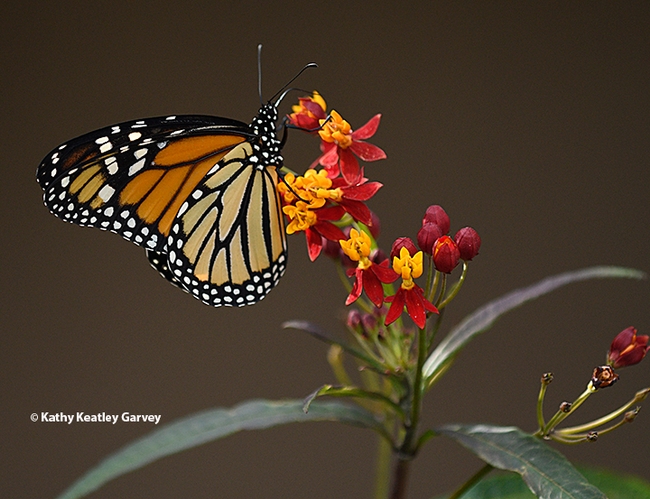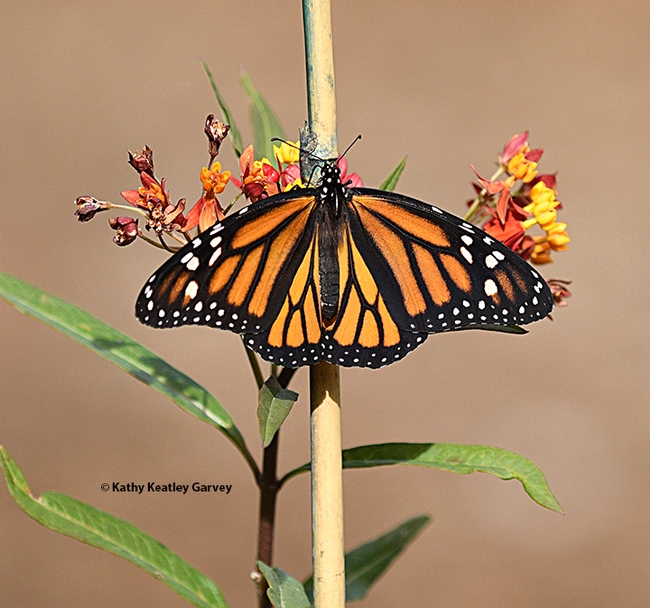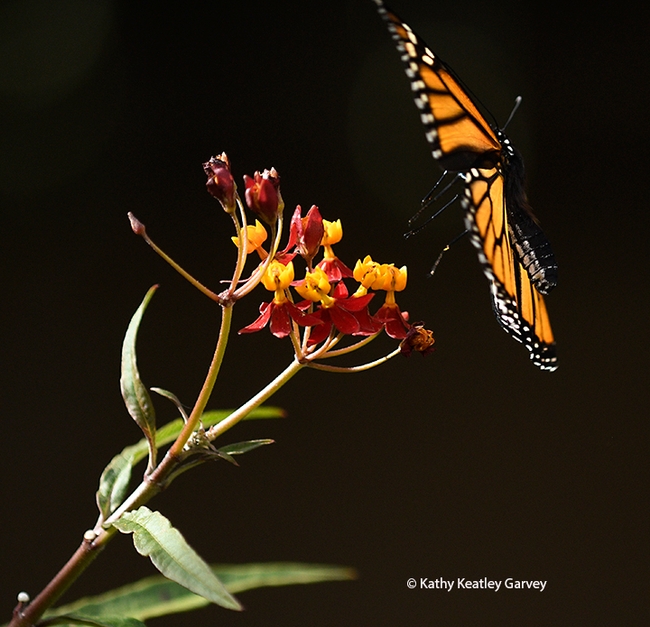It's Wednesday afternoon, Nov. 1 and a female monarch butterfly flutters into our Vacaville pollinator garden.
Me: "Welcome Ms. Monarch! Aren't you a little late for the migration?"
Ms. Monarch: "No, I'm just a late bloomer,. so to speak. I'm heading to Santa Cruz to join my buddies for the winter and then we'll return in February. Right now, I need some nectar, a little flight fuel, to make it to Santa Cruz, if you don't mind."
Me: "Help yourself, Ms. Monarch. Right now we have several plants blooming, including Mexican sunflower, tropical milkweed, zinnias, blanketflower, catmint, roses, foxgloves, and evening primrose. One of your sisters passed through here Oct. 21 and she laid eggs on the tropical milkweed, Asclepias curassavica. She ignored the native milkweed, Asclepias fascicularis, and the other natives we planted."
Ms. Monarch: "Thank you for giving us a choice."
Me: "You're welcome. But watch out for the spiders and praying mantises."
Ms. Monarch: "Hope they won't catch me!"
Me: "I'll check to see where they are. No, don't see them, but that doesn't mean they're not there."
Ms. Monarch, sipping nectar on the tropical milkweed: "This is delicious. You don't mind if I stay 'n sip, sip 'n stay, or awhile?"
Me: "We planted it for you and your brothers and sisters. Well, for other insects, too, like honey bees and syrphid flies, but mainly for you. There's talk, you know, about being endangered."
Ms. Monarch: "Will my sister's eggs survive?
Me: "Well, between the spiders, ants, wasps, lady beetles and milkweed bugs, we can't promise. Hey, even monarch caterpillars will eat the eggs. But we do know this: only 5 percent of the eggs make it to adulthood. So, the odds aren't good. Oops, gotta go. 'Bye for now."
Bohart Museum Open House on Saturday, Nov. 4
Want to talk to a scientist about monarch butterflies? Then you'll want to attend the Bohart Museum of Entomology open house on Saturday, Nov. 4 from 1 to 4 p.m. in Room 1124 of the Academic Surge Building, 455 Crocker Lane. Scientists will be there to answer your questions.
The event is free and family friendly and a great opportunity to learn more about Danaus plexippus.
The scientists will include:
- UC Davis distinguished professor emeritus Art Shapiro of the Department of Evolution and Ecology, who has studied butterfly populations in central California since 1972 and maintains a research website, Art's Butterfly World.
- UC Davis emeritus professor Hugh Dingle, a worldwide authority on animal migration, including monarchs. He is the author of Migration: The Biology of Life on the Move (Oxford University Press), a sequel to the first edition published in 1996. See news story on the UC Davis Entomology and Nematology website.
- UC Davis professor Louie Yang, who does research on monarchs. Due to parental duties, he may be able to attend only the last part of the open house. See news story about his work.
- UC Davis professor Elizabeth Crone of the Department of Evolution and Ecology, formerly of Tufts University, who researches monarchs. See news story about the declining monarch population on the UC Davis Entomology and Nematology website.
- UC Davis postdoctoral fellow Aramee Diethelm of the Elizabeth Crone lab. She holds a doctorate from the University of Nevada, Reno. Both her Ph.D. and postdoctoral work are on monarch butterflies.
The Bohart Museum houses a global collection of eight million insect specimens, plus a living insect petting zoo (Madagascar hissing cockroaches and stick insects, among others), and a insect-themed gift shop. UC Davis distinguished professor Lynn Kimsey has directed the Bohart Museum, founded in 1946, since 1990.
Attached Images:

A female monarch butterfly sipping nectar from a tropical milkweed on Wednesday, Nov. 1 in a Vacaville garden. (Photo by Kathy Keatley Garvey)

The female monarch spreads her wings. (Photo by Kathy Keatley Garvey)

A little flight fuel and the monarch is off to an overwintering site along coastal California. (Photo by Kathy Keatley Garvey)